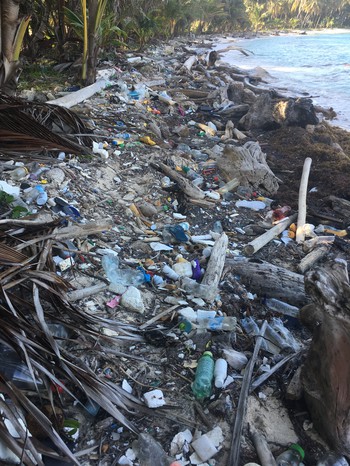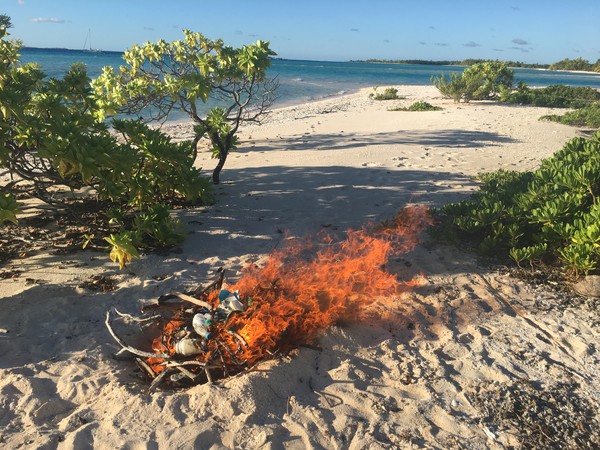
(show on map)
12:15UTC+2

13.08.201911:45UTC+2
Waste disposal at sea
 Unfortunately, we often come to places that are covered with washed-up plastic bottles, shoes, buoys and other flotsam. Partially, the idyllic white sand beaches are hardly to see, so much trash is lying around. But luckily, that's not the case everywhere. People who dump their garbage tons in the sea are isolated cases in many countries. But in others, it's not a peculiarity, so we always have to be vigilant about what happens on land with our garbage, which we separate and clean on board.
Unfortunately, we often come to places that are covered with washed-up plastic bottles, shoes, buoys and other flotsam. Partially, the idyllic white sand beaches are hardly to see, so much trash is lying around. But luckily, that's not the case everywhere. People who dump their garbage tons in the sea are isolated cases in many countries. But in others, it's not a peculiarity, so we always have to be vigilant about what happens on land with our garbage, which we separate and clean on board.
Trash disposal after landfall
Basically, we avoid giving our garbage to boat boys, as they are often earning money by taking the garbage from cruisers and dispose it into the sea. Instead, we search public garbage cans ashore or ask for the garbage collection site. Almost everywhere this strategy works well. However, in some places such as on coral atolls there is no functional waste infrastructure. Only here we burn parts of our garbage (plastic and paper) ashore as the locals do.
Garbage reduction
To reduce waste on board from the start, we leave the bulk of the packaging in the supermarket after shopping. Foods are often packed several times and outer packaging hinders storage on board anyway. Some foods are stored in plastic containers or vacuumed to prevent parasite infestation, so that the original packaging can be disposed of already at provisioning. We only use disposable diapers if we have access to a functioning waste infrastructure. They are partly made of plastic-based deposits and stink terribly, even if they are packed several times. If they were disposed of in the ocean, they would take about 450 years* to completely decompose and endanger fish and other sea creatures. Specifically, this means that disposable diapers on ocean passages or remote islands are not used by us, for these areas we use cloth diapers. Cloth diapers are easily washed by by dragging in a net behind the boat and then need to be rinsed with fresh water.
Waste separation and disposal at sea
On passage, the garbage disposal is only partially possible, so we separate garbage in the following categories: organic waste, plastic waste, glass, cans, paper, wet residual waste, dry waste.
- Organics such as leftovers, fruit and vegetable peel, leftover bread, coffee grounds, fish bones and the like, we dispose of directly in the ocean. Strictly speaking, organics such as orange peels are from other ecological niches and do not belong in the sea. However, they are degraded relatively quickly in the ocean without being - to our knowledge- dangerous to the animals of the sea or to form dangerous degradation products, thus disposal into the sea seems to be acceptable.
- Plastics , including plastic bags, plastic bottles, plastic wrappers, yogurt cups, card boxes, polystyrene, fishing lines an so on we wash and clean before storage to avoid odor. Since the packaging is often very voluminous we cut plastics with a metal scissors into small pieces. A 25 liter bag is sufficient for plastic waste of a family if four for roughly two weeks at sea. When passages are longer, we store full bags in the anchor box until the next landfall. Disposal in the sea is an absolute taboo, because of the very long - sometimes even centuries- degradation processes and the harmful effects on marine animals.
- Glass , screwed or screwed bottles, e.g. we clean and collect the jars of vegetable preserves or marmalades; they are ideal for the odorless storage of moist residual waste. Empty bottles without screw cap, e.g. wine bottles go overboard. How long it takes for a bottle of wine to break down in the ocean is not known. However, glass is a silicate, as is sand, and forms no harmful degradation products as it is gradually being crushed into smaller pieces.
- Metal cans we generally clean, chop and collect for disposal at land. In some cases such as very long ocean passages we did dispose part of the can in the ocean. Tin cans rust and are mined in about 50 years*, aluminum cans take 200 years* to be degraded. This is a long time, but acceptable in our minds on a case by case basis, since aluminum and iron are omnipresent in the ocean and therefore do not constitute harmful substances, as well as their degradation products.
- Paper we collect and bundle it to disposal.
- Wet residual waste , including wet wipes, deposits of meat products or other things that begin to stew on storage, we store in empty bottles and jars. We have so little waste from this category that even a small jam jar lasts one to two weeks.
- Dry residual waste , such as batteries and bulbs, we store separately until they can be properly disposed of.
*) Estimated decomposition times from: NOAA (National Oceanic and Atmospheric Administration, US) / Woods Hole Sea Grants, US. Graphics Oliver Lude
